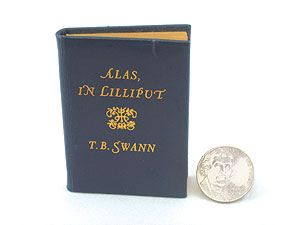
Less is more in miniature book collecting, according to expert Kenneth Gloss.
By Kenneth Gloss
While miniature books are by their very definition smaller than other books, they are every bit as collectible as their larger counterparts. In fact, collecting miniature books has become so popular that enthusiasts have even formed a Miniature Book Society.
Even those who do not primarily collect miniature books may treasure a few and keep them in their collection. Miniatures have been produced on a wide variety of subjects, so someone collecting every edition of Walden or every book on John F. Kennedy will find miniatures to add to their collection as well.
In addition, it isn’t just book collectors who are interested in miniature books, but miniaturists too. Collectors of all things miniature use miniature books to furnish dollhouse libraries. When the dollhouse for the Queen of England was outfitted, they had book designers specially design miniature books for it.
For the most part, today’s miniature books are novelty items, but they didn’t start out that way. Throughout the 1400s and 1500s books were very expensive luxury items that were affordable only to the wealthy, privileged few. Because books had to be portable, mostly for students and people on pilgrimages, they began making them smaller. Some of the books measured four or five inches, but most were even smaller than that.
In the 1700s and 1800s, miniatures began to be made mostly as novelty items. They used less paper and they were made in order to be carried or to be used as gifts. Making a miniature book is very hard work because of the detail involved, but when it’s done right, the result can be truly amazing. Today there are still people who design wonderful miniatures. Bromer Booksellers in Boston publishes classics in miniature and carries limited editions. St. Onge, from Worcester, produced a whole series of miniatures.
Bibles are some of the more popular miniature books. There is one called The Thumb Bible that is literally the size of your thumb. One of my customers collects only miniature Bibles, and has 3,000 of them on little spice shelves throughout her house. Each Bible is a little different from the others.
A company called The Limited Editions Club published Gulliver’s Travels. There are two parts to the book, both packaged in the same box. When Gulliver is a giant, the book is a huge folio. When he is in Lilliput, the book is in miniature.
I have a collection of miniature Shakespeare books with a custom bookcase made by a bookbinder that makes specialty bindings. When you open it, however, it reveals three shelves filled with miniature children’s books.
Oftentimes customers think they have a miniature book in their collection, but it is really just a small book, and not a true miniature. Usually, to be considered miniature a book must measure less than three inches, which is why some miniature books do come with a magnifying glass.
Almanacs, religious books and children’s books are among the most popular of miniature books, along with Lilliput Dictionaries, which fit in the palm of your hand. Miniature books can be bought very reasonably, so even a collector on a budget can find one. There are some in the $10 – $25 range, and a large selection under $200, depending on the type of book and how rare it is.
Just because a book is small, even miniature, doesn’t mean it isn’t collectible. On the contrary, collectors of all types will find that at least one miniature book exists that will complement and enhance their collection.
Ken Gloss is the owner of the Brattle Book Shop in Boston’s Downtown Crossing section. It is America’s oldest antiquarian bookstore and has been owned by the Gloss family for 63 years. Ken has been seen on many of PBS Antiques Roadshow programs appraising books as well as on area radio, TV and cable stations. Further information is available at: www.brattlebookshop.com or by calling 1-800-447-9595.















A friend of mine has a miniature Leather covered book that has the name Shakespeare in gold printed across the top. The book is about 4×3 and comes in a box. I have looked for this book on the internet and cannot find it anywhere. If you could help me find it and what it could be worth would be wonderful. I have a picture of the book cover, I would be happy to send to you if you could help me. Thank you
It’s interesting that miniature books are such a popular collector’s item. I have been interested in printing miniature books, and was wondering what the demand was like. If they are this popular I might start printing, thanks for the information!